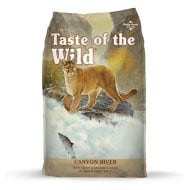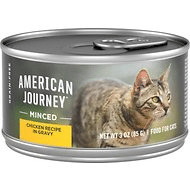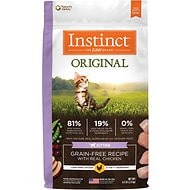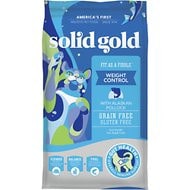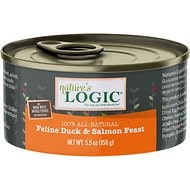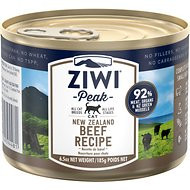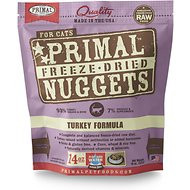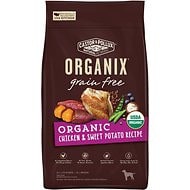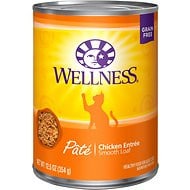Contents
- What Is The Best Gluten Free Cat Food?
- What is Gluten, Anyway?
- Is Gluten Free Cat Food Necessary?
- Special Considerations with Gluten Free Cat Food
- What Should You Look for in a Good Cat Food?
- How Do We Make Cat Food Recommendations?
- The 10 Best Gluten Free Cat Foods
- Smalls Fresh Food Delivery
- Taste of the Wild Canyon River Grain-Free Dry Food
- American Journey Minced Chicken Recipe in Gravy
- Instinct Original Kitten Grain-Free with Real Chicken Freeze-Dried Raw Coated Dry Food
- Solid Gold Fit as a Fiddle Weight Control Alaskan Pollock Grain-Free Adult Dry Food
- Nature’s Logic Feline Duck & Salmon Recipe Grain-Free Canned Food
- 4 More Top-Rated Gluten Free Cat Foods
- Frequently Asked Questions
The gluten free diet is sweeping the globe as food manufacturers seek to appeal to an ever-growing consumer base. The strictest followers of the gluten free diet are people who have an autoimmune condition triggered by gluten called celiac disease and those with gluten sensitivity or intolerance.
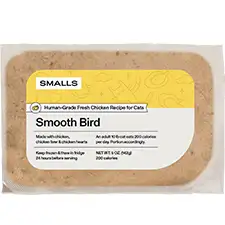
Smalls Human-Grade Ground Bird Fresh Cat Food
- Natural sources of taurine
- High in protein
But what is gluten anyway, and how does it affect your cat? Though gluten gets a bad rap in the human world, it isn’t actually anything that’s inherently dangerous or unhealthy. It’s not necessarily a great ingredient in your cat’s food, but it won’t hurt him. That being said, there are certain implications to consider if you’re thinking about switching your cat to a gluten free diet.
In this article, we’ll talk about gluten free cat food including what gluten is and why you should (or shouldn’t) care. You’ll also learn the basics about gluten free cat food and how to shop for it.
What Is The Best Gluten Free Cat Food?
- Smalls Fresh Food Delivery
- Taste of the Wild Canyon River
- American Journey Minced Chicken
- Instinct Original Kitten Grain-Free
- Solid Gold Fit as a Fiddle Weight Control
- Nature’s Logic Feline Duck & Salmon Recipe
- Ziwi Peak Beef Recipe Canned Cat Food
- Primal Turkey Formula Nuggets Grain-Free
- Castor & Pollux Organix Grain-Free Organic
- Wellness Complete Health Pate Chicken
What is Gluten, Anyway?
Gluten is a type of protein found in cereal grains including wheat, barley, and rye. In human foods, it’s what helps bind ingredients together and it gives bread its spongy texture. Though the fact that it’s a protein might sound like a good thing for your cat, it’s important to remember that gluten comes from plant-based ingredients which are less valuable for your cat than animal ingredients are.
In cat food, you’re most likely to see gluten-containing ingredients in the form of wheat or wheat gluten. Some recipes contain pearled barley, but very few contain rye. If you see the ingredient “corn gluten” or “corn gluten meal” on the label, know that it’s a different kind of gluten – not the kind that triggers a reaction in people with celiac disease.
Is Gluten Free Cat Food Necessary?
As a pet owner, it’s your responsibility to provide for your cat’s needs. In order to do that, you may need to put your own personal preferences aside and do what’s right for your cat. Many pet owners who follow a plant-based diet themselves are starting to enforce the same diet on their pets which, many pet nutrition experts agree, is not a healthy choice.
Though certain healthy plant foods like whole-grain wheat and pearled barley, as well as processed alternatives like wheat gluten, do contain some protein, they aren’t ideal for cats.
Remember, your cat is an obligate carnivore which means his body is simply not adapted to subsisting on plant foods. True carnivores have a short digestive tract and don’t have the necessary bacteria in their gut to efficiently break down plant foods. This is all to say that, gluten free or not, a plant-based diet is not good for your cat.
But is gluten free cat food still necessary?
Generally speaking, there’s nothing particularly unhealthy about gluten. Remember, however, that it is a plant-based protein and therefore less biologically valuable for your cat than animal protein. Gluten-containing whole grains can provide certain nutrients and dietary fiber, but they shouldn’t make up a significant portion of your cat’s diet.
Special Considerations with Gluten Free Cat Food
When shopping for gluten free cat food, you should remember that gluten isn’t just found in wheat – it’s also found in barley and rye. Many pet food manufacturers will mention their product being gluten free on the label, but it isn’t as big a claim as being grain free.
Keep in mind that any cat food that is completely grain free will also likely be gluten free. It’s pretty uncommon for pet food manufacturers to use gluten-containing ingredients other than grains.
If you’re thinking about feeding your cat gluten free food, ask yourself why. In humans, a gluten free diet is a medical necessity for people with celiac disease and gluten sensitivities. Celiac disease is not a concern for cats, but food allergies can be. The most common cat food allergies, however, are animal proteins like chicken and beef. Grain allergies are not as common as pet food manufacturers would have you believe, so unless your cat has a wheat allergy, a grain free diet may not be necessary.
That being said, wheat is generally a less nutritious option for cats than other whole grains like brown rice or oatmeal. If you’re concerned about gluten but don’t need to go fully grain free, look for a cat food made with whole grains like these instead.
What Should You Look for in a Good Cat Food?
When it comes to shopping for cat food, gluten free shouldn’t be the first thing you look for. Remember that protein should be the foundation of your cat’s diet, and it should come primarily from animal sources. Carbohydrates, even gluten free ones, should be in very limited quantity and certainly secondary to protein and fat. There’s no harm in shopping for gluten free cat foods, but make sure to focus on what really matters above all.
Here are some things to look for in a good cat food:
- Real animal protein as the first ingredient. A named source of meat, poultry, or fish should be the first ingredient (and ideally two of the first three) in your cat’s food. Plant proteins like pea protein and potato protein are less biologically valuable than things like chicken or beef meal.
- Healthy animal-based fats. Fat acts as a source of energy for your cat and helps his body absorb fat-soluble vitamins. Like protein, it is most biologically valuable from animal sources, but it needs to be in balance with protein to keep the calorie content of the recipe moderate.
- Digestible carbohydrates and low-starch veggies. The lower the carb content of your cat’s food, the better, but digestibility matters as well. Whole grains like brown rice and oatmeal are more nutritious than refined grains like wheat and corn. Look for low-starch veggies as well.
- No artificial colors, flavors, or preservatives. These ingredients may improve the appearance of cat food but that’s not what your cat is concerned about. Artificial colors, flavors, and preservatives play no beneficial role in your cat’s diet.
- Limited use of synthetic supplements. Most cat foods contain a list of added vitamins and minerals at the end, but you’ll also see free amino acids sometimes. The fewer additives in the product, generally speaking, the higher the quality. Added supplements usually means lower quality in the main ingredients or that there’s been significant nutrient loss during processing.
Now that you know what to look for in a high-quality cat food in general, you’re ready to start shopping on your own! Before you do, however, we want to tell you how we make our cat food recommendations so you know whether you can trust the picks we’ve reviewed in depth below.
How Do We Make Cat Food Recommendations?
You want to give your cat the best, so we understand why you might be skeptical to follow someone else’s advice. We can assure you that we’d never recommend a product we wouldn’t happily feed our own cats and our recommendations are based on a significant amount of research and experience.
Here are some general requirements for a cat food recipe to receive our stamp of approval:
- A source of high-quality animal protein as the first ingredient
- At least 30% crude protein for kittens and at least 26% for adults
- A minimum of 9% crude fat for kittens and adults
- A balance of omega-3 and omega-6 fatty acids, primarily from animal sources
- A rich blend of nutrients from natural sources and supplements, as needed
- Limited carbohydrate content from digestible sources (like whole grains and veggies)
- No low-quality fillers, by-products, or artificial additives (preservatives, dyes, or flavors)
The 10 Best Gluten Free Cat Foods
When shopping for gluten free cat food, checking for the “grain free” designation is the easiest way to go. There’s no guarantee that a grain free product will also be gluten free, but it’s highly likely. Many pet food manufacturers also include the words “gluten free” on the label. If you’re still looking for some recommendations to get you started, here are our top picks:
| Our 2024 Picks: Overall Best Gluten Free Cat Foods | |||
Smalls Fresh Cat Food
|
CHECK PRICE | ||
Taste Of The Wild Canyon River Grain-Free
|
CHECK PRICE | ||
American Journey Minced Chicken Recipe
|
CHECK PRICE | ||
Instinct Original Kitten Grain-Free
|
CHECK PRICE | ||
Solid Gold Fit as a Fiddle Weight Control
|
CHECK PRICE | ||
Nature’s Logic Feline Duck & Salmon
|
CHECK PRICE | ||
Ziwi Peak Beef Recipe Canned Cat Food
|
CHECK PRICE | ||
Primal Turkey Formula Nuggets
|
CHECK PRICE | ||
Castor & Pollux Organix Grain-Free
|
CHECK PRICE | ||
Wellness Complete Health Pate Chicken
|
CHECK PRICE | ||
Smalls Fresh Food Delivery
Our Top Overall Pick: If you want to maximize your cat’s nutrition, choose a product that approximates his natural diet as closely as possible. This means high protein inclusions, low carbohydrate content, and high moisture. Many pet experts believe fresh food is one of the best options out there. Smalls is our favorite brand because they use only the finest natural ingredients and cook their food in small batches at low temperatures to preserve the nutritional integrity. They offer a chicken and a fish recipe, both made with real animal protein as the main ingredient. Both recipes are also completely grain free and gluten free, so you can rest easy about that as well. Keep in mind that the price for fresh food is higher than most kibbles, but it may be similar to premium-quality canned food.
Taste of the Wild Canyon River Grain-Free Dry Food
Most Popular Gluten Free Cat Food: When you can’t decide what brand to go with, Taste of the Wild is a popular choice worth considering. This brand is known for their high-quality, grain-free and gluten-free cat foods made with premium roasted meats. This Canyon River recipe is packed with premium protein like real trout, ocean fish meal, and smoked salmon. It contains healthy carbohydrates like sweet potatoes as well as fresh fruits and vegetables to deliver a natural dose of key nutrients. This recipe is supplemented with dried fermentation products which act as probiotics to support healthy digestive, helping increase the absorption of nutrients along with prebiotic fiber and naturally occurring microorganisms.
American Journey Minced Chicken Recipe in Gravy
Most Affordable Gluten Free Cat Food: Affordable cat food doesn’t have to be low quality and this American Journey Minced Chicken Recipe is proof of that. American Journey is Chewy’s in-house brand, developed to provide the ideal combination of quality and affordability. This recipe features fresh chicken as the main ingredient with both chicken and turkey broth for flavor and moisture. Chicken liver provides a supplemental source of protein as well as key nutrients with fresh cranberries and blueberries for support. Though many low-quality cat foods cooked in gravy contain wheat flour as thickener, this recipe doesn’t. It is completely free from gluten and grains, making it highly digestible and nutritious for your cat.
Instinct Original Kitten Grain-Free with Real Chicken Freeze-Dried Raw Coated Dry Food
Best Gluten Free Kitten Food: Your kitten deserves the best start in life you can possibly give him and this Instinct Original Kitten recipe is a great option. This high-protein kibble is coated with freeze-dried raw meat for a boost of flavor and protein, providing a total of 81% real animal ingredients. It features fresh chicken, turkey meal, and menhaden fish meal as the first three ingredients followed by peas as the primary source of gluten free carbohydrate. This recipe is supplemented with several other sources of animal protein with fresh fruits and veggies to provide natural sources for key nutrients.
Solid Gold Fit as a Fiddle Weight Control Alaskan Pollock Grain-Free Adult Dry Food
Best Gluten Free Senior Cat Food: Clearly marked gluten free on the front of the package, this Fit as a Fiddle Weight Control formula from Solid Gold could be a good option for your senior cat. It features Alaskan pollock as the main ingredient with turkey meal, ocean fish meal, and chicken meal as supplemental sources of protein. Peas, tapioca, and chickpeas are the main carbohydrates, all of which are gluten free and grain free. This recipe contains 31% crude protein with just 9% fat and 360 calories per cup. Keep in mind that while this recipe is gluten free and grain free, the carbohydrate content as a whole is a little high in comparison to the fat and protein content.
Nature’s Logic Feline Duck & Salmon Recipe Grain-Free Canned Food
Best Gluten Free Cat Food for Sensitive Stomach: If your cat has food allergies or a sensitive stomach, you want to avoid any artificial additives as well as common allergens. This duck and salmon feast from Nature’s Logic contains a very limited list of ingredients to reduce the risk for triggering an allergy and doesn’t contain any synthetic additives at all – not even vitamins and minerals. This recipe features fresh duck and salmon as whole sources of carbohydrate with organ meats for additional protein. Dried fruits and vegetables provide natural sources of key vitamins and minerals, making the recipe highly digestible overall.
4 More Top-Rated Gluten Free Cat Foods
Ziwi Peak Beef Recipe Canned Cat Food
One of the healthiest wet cat food options on our list is this Ziwi Peak Beef Recipe Canned Cat Food. Made with 92% meat, organs, and New Zealand green mussels, not only is this recipe gluten free but it is nearly carbohydrate-free as well. Fresh beef is the first ingredient with supplemental protein from beef lung, kidney, tripe, and liver. New Zealand green mussels provide a natural source of joint-supporting glucosamine and chondroitin while chickpeas act as the sole carbohydrate ingredients.
Primal Turkey Formula Nuggets Grain-Free Raw Freeze Dried Cat Food
To give your cat the nutritional benefits of raw food without the hassle, try this Primal Freeze Dried Cat Food. These freeze dried nuggets are made with 93% turkey, organs, and bone with the remaining 7% made up of organic fruits and veggies and healthy fats. This recipe is packed with protein and natural flavor, though you should know that freeze dried foods should be rehydrated before feeding. Cats tend not to drink a lot of water and such a low-moisture food might exacerbate the issue.
Castor & Pollux Organix Grain-Free Organic Chicken & Sweet Potato Recipe
Another high-quality dry food option is this Castor & Pollux Organix Grain-Free Organic Chicken & Sweet Potato Recipe. Featuring USDA organic ingredients like free-range chicken, sweet potatoes, and peas, this recipe is rich in protein and highly digestible. It is free from gluten and grains but packed with nutritional quality. As an organic cat food, you can rest assured that none of the proteins are raised with added hormones or antibiotics and that the produce is free from pesticides and herbicides.
Wellness Complete Health Pate Chicken Entrée Grain-Free Canned Food
If you’re looking for an affordable wet food that’s also gluten free, consider this Wellness Complete Health Pate Chicken Entrée. Packed with lean protein, this formula is designed to support the five signs of cat wellness: healthy skin and coat, healthy digestion, bright eyes and strong teeth, high energy, and strong immunity. It contains antioxidant-rich cranberries and plenty of moisture to support your cat’s digestion and urinary health.
Frequently Asked Questions
- Do cats need a gluten free diet? There is no all-encompassing answer to this question because different cats have unique dietary needs and preferences. Gluten is certainly not a necessary ingredient in your cat’s diet, but it isn’t all bad. It’s simply a type of protein found in wheat, barley, and rye. Whole grains in limited amounts can add certain nutrients as well as fiber to your cat’s diet, but plant-based ingredients are inherently less biologically valuable for cats than animal ingredients.
- Is grain free food good for cats? Though pet food manufacturers have led consumers to believe otherwise, grain allergies are generally not the most common cat food allergies. In fact, it’s animal proteins like chicken and beef that are more likely to cause a reaction in sensitive cats. The only time you need to feed your cat a grain free cat food is if he has a confirmed allergy to grains. Many people assume that grain free means a cat food is also low in carbohydrates, but that isn’t necessarily true. A high-quality cat food rich in animal protein with low content of whole grains is typically better than the average grain free cat food because these tend to be high carb and have a higher concentration of plant proteins.
- What is gluten used for in cat food? Gluten-containing ingredients are often added to pet food to increase the protein content. You’ll see things like wheat gluten or corn gluten meal in lower quality products where the manufacturer is trying to increase the protein percentage on the label without significantly increasing their costs. This is why it’s important not just to check the guaranteed analysis, but to also review the list of ingredients on your cat’s food so you can make sure the nutrients listed come from quality sources.
- What about vegan and vegetarian cat food? As we mentioned earlier, vegan and vegetarian cat food is not ideal. It’s not even biologically appropriate. Vegan pet food manufacturers will tell you cats can get all the protein they need from plant sources, but what they’re not telling you is that it isn’t the ideal diet. Plant proteins contain essential amino acids, but only animal proteins are considered “complete” proteins – they contain all of the amino acids your cat needs. Many vegan and vegetarian cat foods rely on free amino acids being added back into the food to meet your cat’s minimum requirements. Remember, what’s most important is feeding your cat a diet biologically appropriate for his body – your own dietary preferences don’t factor into this decision.
- How do I know if my cat is allergic to gluten? Allergies in cats often present with different symptoms than they do in humans. Though digestive issues like chronic diarrhea and vomiting may be involved, recurrent ear infections and skin or coat problems are more telling. The thing to remember is that cats can develop an allergy to just about anything in their food, so before you assume it’s gluten, ask yourself if you’re sure. If you’re not, try switching to a cat food made with a different source of animal protein. A true gluten allergy is fairly rare in cats, so it’s worth ruling out other potential allergens first.
If you follow a gluten free diet based on medical necessity or you’ve simply hopped on board with the trend, don’t assume that your cat should too. Your nutritional needs vary significantly from your cat’s, and so does your body’s ability to digest plant foods. Gluten doesn’t provide more nutritional benefit than animal protein, but it isn’t necessarily harmful for your cat.
Before you go and spend a small fortune on a fancy gluten free cat food, ask yourself whether it’s really necessary. If gluten is the concern, all you really have to do is look for a recipe that doesn’t contain wheat, barley, or rye. To get started in your search, try one of the recipes recommended above.

